Analysis of Pyrrolizidine Alkaloids in Stingless Bee Honey and Identification of a Botanical Source as Ageratum conyzoides
Abstract
1. Introduction
2. Results and Discussion
2.1. Quantitation of Stingless Bee Honey Alkaloids against Pyrrolizidine Alkaloid Standards
2.2. Untargeted Analysis of Novel PAs in Stingless Bee Honey Samples
2.3. Survey of Alkaloids in Chromolaena odorata L.
2.4. Pyrrolizidine Alkaloids Determined in Weed Ageratum conyzoides L.
2.5. Honey PA Profiles Linked to A. conyzoides
2.6. Health Implications of Different PA Types
3. Materials and Methods
3.1. Chemical and Solvents
3.2. Honey Samples
3.3. Stingless Bee Honey Samples for Quantitation against PA Standards
3.4. Stingless Bee Honey Samples for Comparison with Malaysian Plants
3.5. Honey Method Validation
3.6. Malaysian Plant Alkaloid Extraction
3.6.1. Plant Sources
3.6.2. Plant Extraction and Zinc Reduction
3.7. HRAM LC-MS/MS Analysis Using PA Standards
3.8. HRAM UHPLC-MS/MS Analysis for the Identification of PAs Other Than the Targeted PA Standards
Supplementary Materials
Author Contributions
Funding
Institutional Review Board Statement
Informed Consent Statement
Data Availability Statement
Acknowledgments
Conflicts of Interest
References
- Heard, T. The Australian Native Bee Book. Keeping Stingless Bee Hives for Pets, Pollination and Sugarbag Honey; Sugarbag Bees: West End, QLD, Australia, 2016. [Google Scholar]
- Zawawi, N.; Zhang, J.; Hungerford, N.L.; Yates, H.S.A.; Webber, D.C.; Farrell, M.; Tinggi, U.; Bhandari, B.; Fletcher, M.T. Unique physicochemical properties and rare reducing sugar trehalulose mandate new international regulation for stingless bee honey. Food Chem. 2022, 373, 131566. [Google Scholar] [CrossRef] [PubMed]
- Abd Jalil, M.A.; Kasmuri, A.R.; Hadi, H. Stingless bee honey, the natural wound healer: A review. Skin Pharmacol. Physiol. 2017, 30, 66–75. [Google Scholar] [CrossRef] [PubMed]
- Fletcher, M.T.; Hungerford, N.L.; Webber, D.; Carpinelli de Jesus, M.; Zhang, J.; Stone, I.S.J.; Blanchfield, J.T.; Zawawi, N. Stingless bee honey, a novel source of trehalulose: A biologically active disaccharide with health benefits. Sci. Rep. 2020, 10, 12128. [Google Scholar] [CrossRef] [PubMed]
- Martínez-Puc, J.F.; Cetzal-Ix, W.; Basu, S.K.; Enríquez-Nolasco, J.R.; Magaña-Magaña, M.A. Nutraceutical and medicinal properties of native stingless bees honey and their contribution to human health. In Functional Foods and Nutraceuticals in Metabolic and Non-Communicable Diseases; Singh, R.B., Watanabe, S., Isaza, A.A., Eds.; Academic Press: London, UK, 2022; pp. 481–489. [Google Scholar]
- Smith, L.W.; Culvenor, C.C. Plant sources of hepatotoxic pyrrolizidine alkaloids. J. Nat. Prod. 1981, 44, 129–152. [Google Scholar] [CrossRef] [PubMed]
- Hungerford, N.L.; Carter, S.J.; Anuj, S.R.; Tan, B.L.L.; Hnatko, D.; Martin, C.L.; Sharma, E.; Yin, M.; Nguyen, T.T.P.; Melksham, K.J.; et al. Analysis of pyrrolizidine alkaloids in Queensland honey: Using low temperature chromatography to resolve stereoisomers and identify botanical sources by UHPLC-MS/MS. Toxins 2019, 11, 726. [Google Scholar] [CrossRef]
- Pearson, A.J.; Nicolas, J.E.F.; Lancaster, J.E.; Symes, C.W. Characterization and lifetime dietary risk assessment of eighteen pyrrolizidine alkaloids and pyrrolizidine alkaloid N-oxides in New Zealand honey. Toxins 2021, 13, 843. [Google Scholar] [CrossRef]
- Picron, J.F.; Herman, M.; Van Hoeck, E.; Goscinny, S. Monitoring of pyrrolizidine alkaloids in beehive products and derivatives on the Belgian market. Environ. Sci. Pollut. Res. Int. 2020, 27, 5693–5708. [Google Scholar] [CrossRef]
- Griffin, C.T.; Mitrovic, S.M.; Danaher, M.; Furey, A. Development of a fast isocratic LC-MS/MS method for the high-throughput analysis of pyrrolizidine alkaloids in Australian honey. Food Addit. Contam. Part A 2015, 32, 214–228. [Google Scholar] [CrossRef]
- Beekman, M.; Ratnieks, F.L.W. Long-range foraging by the honey-bee, Apis mellifera L. Funct. Ecol. 2000, 14, 490–496. [Google Scholar] [CrossRef]
- Smith, J.P.; Heard, T.A.; Beekman, M.; Gloag, R. Flight range of the Australian stingless bee Tetragonula carbonaria (Hymenoptera: Apidae). Austral. Entomol. 2016, 56, 50–53. [Google Scholar] [CrossRef]
- Coelho, G.R.; Figueiredo, C.A.; Negri, G.; Fernandes-Silva, C.C.; Villar, K.D.S.; Badari, J.C.; Oliveira, M.I.D.; Barbosa, T.F.; Taniwaki, N.N.; Namiyama, G.M.; et al. Antiviral activity of geopropolis extract from Scaptotrigona aff. postica against rubella virus. J. Food Res. 2018, 7, 91–106. [Google Scholar] [CrossRef]
- Coelho, G.R.; Mendonca, R.Z.; Vilar Kde, S.; Figueiredo, C.A.; Badari, J.C.; Taniwaki, N.; Namiyama, G.; de Oliveira, M.I.; Curti, S.P.; Evelyn Silva, P.; et al. Antiviral action of hydromethanolic extract of geopropolis from Scaptotrigona postica against antiherpes simplex virus (HSV-1). Evid. Based Complement. Alternat. Med. 2015, 2015, 296086. [Google Scholar] [CrossRef] [PubMed]
- Negri, G.; Salatino, A.; Pereira, L.L.R.; Salatino, M.L.F.; Nascimento, R.M.; Mendonça, R.Z. A highly complex stingless bee propolis: Composition and influence of the period of collection. JSFA Rep. 2022, 2, 64–80. [Google Scholar] [CrossRef]
- Cantero, T.M.; Silva Junior, P.I.; Negri, G.; Nascimento, R.M.; Mendonça, R.Z. Antimicrobial activity of flavonoids glycosides and pyrrolizidine alkaloids from propolis of Scaptotrigona aff. postica. Toxin Rev. 2022, 42, 300–315. [Google Scholar] [CrossRef]
- Flavia Massaro, C.; Villa, T.F.; Hauxwell, C. Metabolomics analysis of pot-pollen from three species of Australian stingless bees (Meliponini). In Pot-Pollen in Stingless Bee Melittology; Vit, P., Pedro, S.R.M., Roubik, D.W., Eds.; Springer International Publishing AG: Cham, Switzerland, 2018; pp. 401–417. [Google Scholar] [CrossRef]
- Commmission Regulation. Commission Regulation (EU) 2020/2040 of 11 December 2020 amending Regulation (EC) No 1881/2006 as regards maximum levels of pyrrolizidine alkaloids in certain foodstuffs. J. Eur. Union Off. J. Eur. Union 2020, L 420, 1–4. [Google Scholar]
- Carpinelli de Jesus, M.; Hungerford, N.L.; Carter, S.J.; Anuj, S.R.; Blanchfield, J.T.; De Voss, J.J.; Fletcher, M.T. Pyrrolizidine alkaloids of blue heliotrope (Heliotropium amplexicaule) and their presence in Australian honey. J. Agric. Food Chem. 2019, 67, 7995–8006. [Google Scholar] [CrossRef] [PubMed]
- Rizzo, S.; Celano, R.; Piccinelli, A.L.; Russo, M.; Rastrelli, L. Target screening method for the quantitative determination of 118 pyrrolizidine alkaloids in food supplements, herbal infusions, honey and teas by liquid chromatography coupled to quadrupole orbitrap mass spectrometry. Food Chem. 2023, 423, 136306. [Google Scholar] [CrossRef]
- Rizzo, S.; Celano, R.; Piccinelli, A.L.; Serio, S.; Russo, M.; Rastrelli, L. An analytical platform for the screening and identification of pyrrolizidine alkaloids in food matrices with high risk of contamination. Food Chem. 2023, 406, 135058. [Google Scholar] [CrossRef]
- Klein, L.M.; Gabler, A.M.; Rychlik, M.; Gottschalk, C.; Kaltner, F. A sensitive LC-MS/MS method for isomer separation and quantitative determination of 51 pyrrolizidine alkaloids and two tropane alkaloids in cow’s milk. Anal. Bioanal. Chem. 2022, 414, 8107–8124. [Google Scholar] [CrossRef]
- Shimshoni, J.A.; Barel, S.; Mulder, P.P.J. Comparative risk assessment of three native Heliotropium species in Israel. Molecules 2021, 26, 689. [Google Scholar] [CrossRef]
- Witte, L.; Rubiolo, P.; Bicchi, C.; Hartmann, T. Comparative analysis of pyrrolizidine alkaloids from natural sources by gas chromatography-mass spectrometry. Phytochemistry 1993, 32, 187–196. [Google Scholar] [CrossRef]
- El-Shazly, A.; Wink, M. Diversity of pyrrolizidine alkaloids in the Boraginaceae structures, distribution, and biological properties. Diversity 2014, 6, 188–282. [Google Scholar] [CrossRef]
- Trigo, J.R.; Barata, L.E.S.; Brown, K.S., Jr. Stereochemical inversion of pyrrolizidine alkaloids by Mechanitis polymnia (Lepidoptera: Nymphalidae: Ithomiinae): Specificity and evolutionary significance. J. Chem. Ecol. 1994, 20, 2883–2899. [Google Scholar] [CrossRef]
- Roeder, E.; Breitmaier, E.; Birecka, H.; Frohlicht, M.W.; Badzies-Crombach, A. Pyrrolizidine alkaloids of Heliotropium spathulatum. Phytochemistry 1991, 30, 1703–1706. [Google Scholar] [CrossRef]
- Ruan, J.; Li, N.; Xia, Q.; Fu, P.P.; Peng, S.; Ye, Y.; Lin, G. Characteristic ion clusters as determinants for the identification of pyrrolizidine alkaloid N-oxides in pyrrolizidine alkaloid-containing natural products using HPLC-MS analysis. J. Mass Spectrom. 2012, 47, 331–337. [Google Scholar] [CrossRef]
- These, A.; Bodi, D.; Ronczka, S.; Lahrssen-Wiederholt, M.; Preiss-Weigert, A. Structural screening by multiple reaction monitoring as a new approach for tandem mass spectrometry: Presented for the determination of pyrrolizidine alkaloids in plants. Anal. Bioanal. Chem. 2013, 405, 9375–9383. [Google Scholar] [CrossRef]
- Omokhua, A.G.; McGaw, L.J.; Finnie, J.F.; Van Staden, J. Chromolaena odorata (L.) R.M. King & H. Rob. (Asteraceae) in sub-Saharan Africa: A synthesis and review of its medicinal potential. J. Ethnopharmacol. 2016, 183, 112–122. [Google Scholar] [CrossRef]
- Zachariades, C.; Day, M.; Muniappan, R.; Reddy, G.V.P. Chromolaena odorata (L.) King and Robinson (Asteraceae). In Biological Control of Tropical Weeds Using Arthropods; Muniappan, R., Ed.; Cambridge University Press: Cambridge, UK, 2009. [Google Scholar]
- Biller, A.; Boppré, M.; Witte, L.; Hartmann, T. Pyrrolizidine alkaloids in Chromolaena odorata. Chemical and chemoecological aspects. Phytochemistry 1994, 35, 615–619. [Google Scholar] [CrossRef]
- Dube, N.; van Heerden, F.R.; Zachariades, C.; Uyi, O.O.; Munyai, T.C. First record of pyrrolizidine alkaloids in the southern African biotype of Chromolaena odorata (asteraceae). S. Afr. J. Bot. 2021, 139, 19–25. [Google Scholar] [CrossRef]
- Okunade, A.L. Ageratum conyzoides L. (asteraceae). Fitoterapia 2002, 73, 1–16. [Google Scholar] [CrossRef]
- Faqueti, L.G.; Sandjo, L.P.; Biavatti, M.W. Simultaneous identification and quantification of polymethoxyflavones, coumarin and phenolic acids in Ageratum conyzoides by UPLC-ESI-QToF-MS and UPLC-PDA. J. Pharm. Biomed. Anal. 2017, 145, 621–628. [Google Scholar] [CrossRef] [PubMed]
- Wiedenfeld, H.; Roder, E. Pyrrolizidine alkaloids from Ageratum conyzoides. Planta Med. 1991, 57, 578–579. [Google Scholar] [CrossRef] [PubMed]
- Bosi, C.F.; Rosa, D.W.; Grougnet, R.; Lemonakis, N.; Halabalaki, M.; Skaltsounis, A.L.; Biavatti, M.W. Pyrrolizidine alkaloids in medicinal tea of Ageratum conyzoides. Rev. Bras. Farmacogn. 2013, 23, 425–432. [Google Scholar] [CrossRef]
- Molyneux, R.J.; Gardner, D.L.; Colegate, S.M.; Edgar, J.A. Pyrrolizidine alkaloid toxicity in livestock: A paradigm for human poisoning? Food Addit. Contam. Part A 2011, 28, 293–307. [Google Scholar] [CrossRef] [PubMed]
- Avula, B.; Sagi, S.; Wang, Y.-H.; Zweigenbaum, J.; Wang, M.; Khan, I.A. Characterization and screening of pyrrolizidine alkaloids and N-oxides from botanicals and dietary supplements using UHPLC-high resolution mass spectrometry. Food Chem. 2015, 178, 136–148. [Google Scholar] [CrossRef]
- Jiao, W.; Shen, T.; Wang, L.; Zhu, L.; Li, Q.X.; Wang, C.; Chen, H.; Hua, R.; Wu, X. Source and route of pyrrolizidine alkaloid contamination in tea samples. J. Vis. Exp. 2022, 187, e64375. [Google Scholar] [CrossRef]
- Wiedenfeld, H. Plants containing pyrrolizidine alkaloids: Toxicity and problems. Food Addit. Contam. Part A 2011, 28, 282–292. [Google Scholar] [CrossRef]
- Colegate, S.M.; Gardner, D.R.; Betz, J.M.; Panter, K.E. Semi-automated separation of the epimeric dehydropyrrolizidine alkaloids lycopsamine and intermedine: Preparation of their N-oxides and NMR comparison with diastereoisomeric rinderine and echinatine. Phytochem. Anal. 2014, 25, 429–438. [Google Scholar] [CrossRef]
- Colegate, S.M.; Gardner, D.R.; Joy, R.J.; Betz, J.M.; Panter, K.E. Dehydropyrrolizidine alkaloids, including monoesters with an unusual esterifying acid, from cultivated Crotalaria juncea (Sunn Hemp cv. ‘Tropic Sun’). J. Agric. Food Chem. 2012, 60, 3541–3550. [Google Scholar] [CrossRef]
- Pedersen, E.; Larsen, E. Mass spectrometry of some pyrrolizidine alkaloids. Org. Mass Spectrom. 1970, 4, 249–256. [Google Scholar] [CrossRef]
- Fu, P.P.; Xia, Q.; Lin, G.; Chou, M.W. Pyrrolizidine alkaloids—Genotoxicity, metabolism enzymes, metabolic activation, and mechanisms. Drug Metab. Rev. 2004, 36, 1–55. [Google Scholar] [CrossRef]
- Yan, X.; Kang, H.; Feng, J.; Yang, Y.; Tang, K.; Zhu, R.; Yang, L.; Wang, Z.; Cao, Z. Identification of toxic pyrrolizidine alkaloids and their common hepatotoxicity mechanism. Int. J. Mol. Sci. 2016, 17, 318. [Google Scholar] [CrossRef]
- Edgar, J.A.; Molyneux, R.J.; Colegate, S.M. Pyrrolizidine alkaloids: Potential role in the etiology of cancers, pulmonary hypertension, congenital anomalies, and liver disease. Chem. Res. Toxicol. 2015, 28, 4–20. [Google Scholar] [CrossRef]
- Stegelmeier, B.L.; Colegate, S.M.; Brown, A.W. Dehydropyrrolizidine alkaloid toxicity, cytotoxicity, and carcinogenicity. Toxins 2016, 8, 356. [Google Scholar] [CrossRef] [PubMed]
- Culvenor, C.C.J.; Edgar, J.A.; Jago, M.V.; Outteridge, A.; Peterson, J.E.; Smith, L.W. Hepato- and pneumotoxicity of pyrrolizidine alkaloids and derivatives in relation to molecular structure. Chem.-Biol. Interact. 1976, 12, 299–324. [Google Scholar] [CrossRef]
- European Food Safety Authority. Risks for human health related to the presence of pyrrolizidine alkaloids in honey, tea, herbal infusions and food supplements. EFSA J. 2017, 15, 4908. [Google Scholar] [CrossRef]
- Culvenor, C.C.J.; Edgar, J.A.; Smith, L.W. Pyrrolizidine alkaloids in honey from Echium plantagineum L. J. Agric. Food Chem. 1981, 29, 958–960. [Google Scholar] [CrossRef]
- He, Y.; Zhu, L.; Ma, J.; Wong, L.; Zhao, Z.; Ye, Y.; Fu, P.P.; Lin, G. Comprehensive investigation and risk study on pyrrolizidine alkaloid contamination in Chinese retail honey. Environ. Pollut. 2020, 267, 115542. [Google Scholar] [CrossRef]
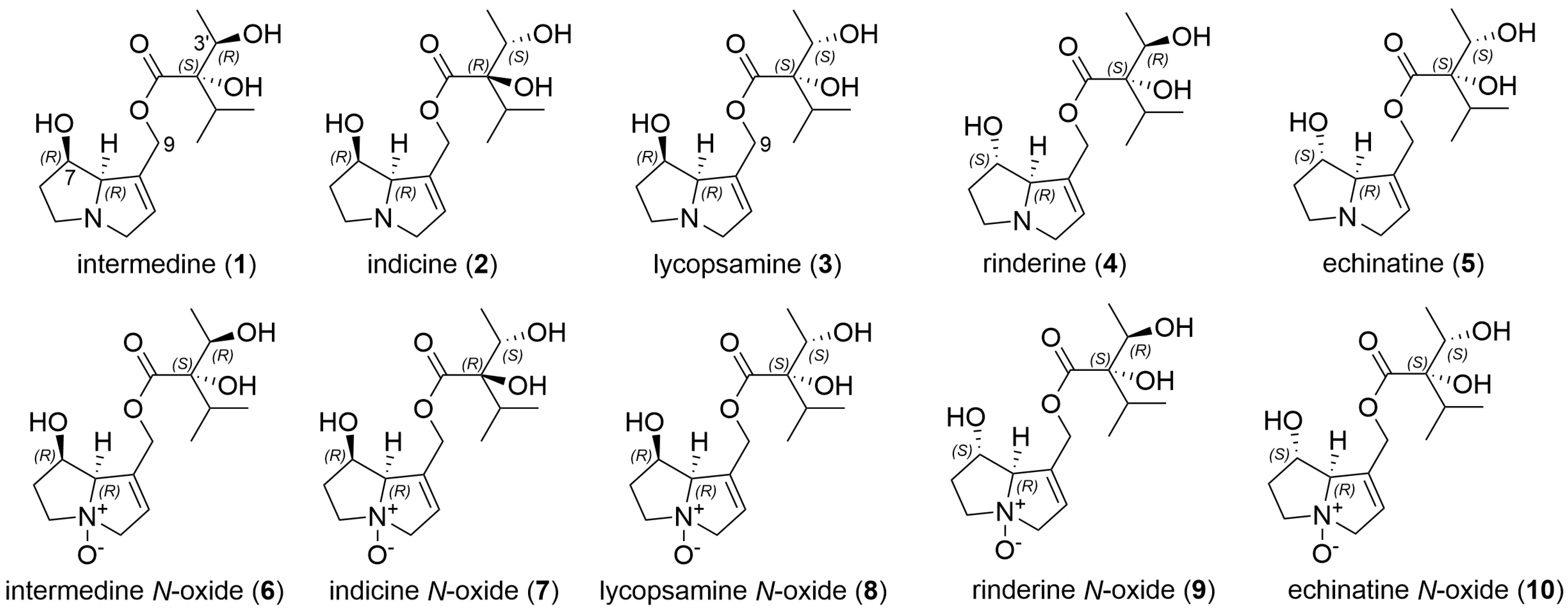
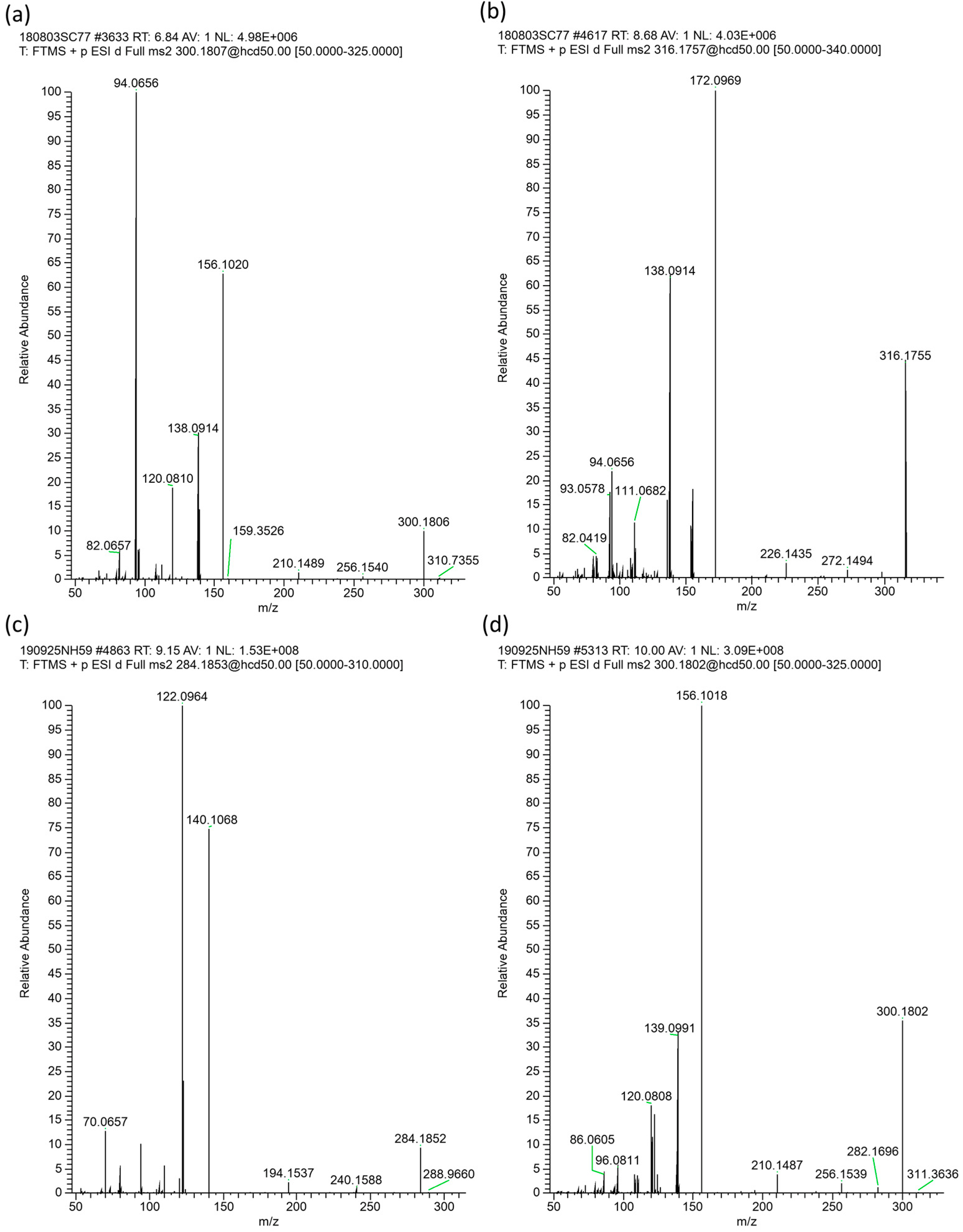

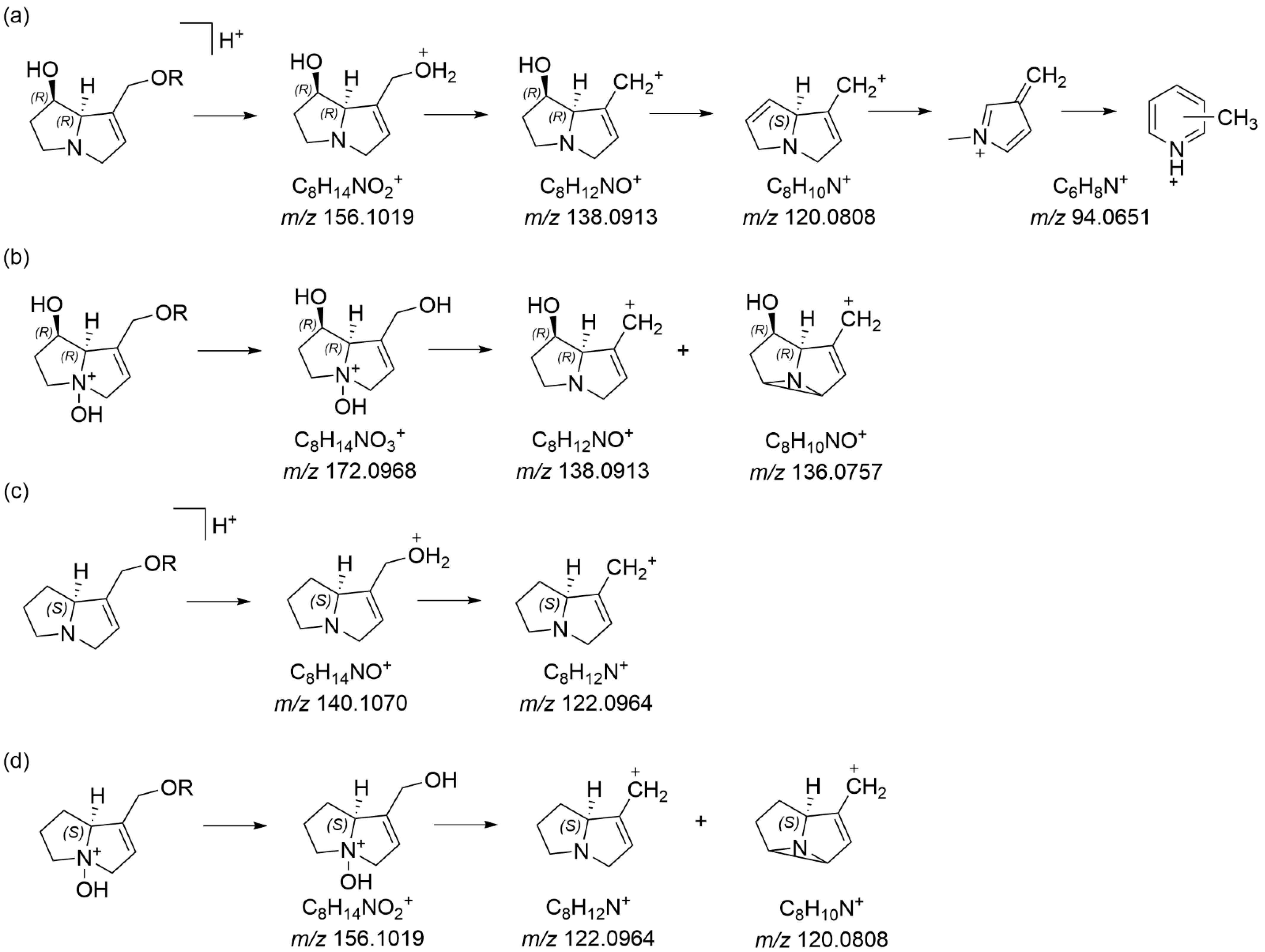

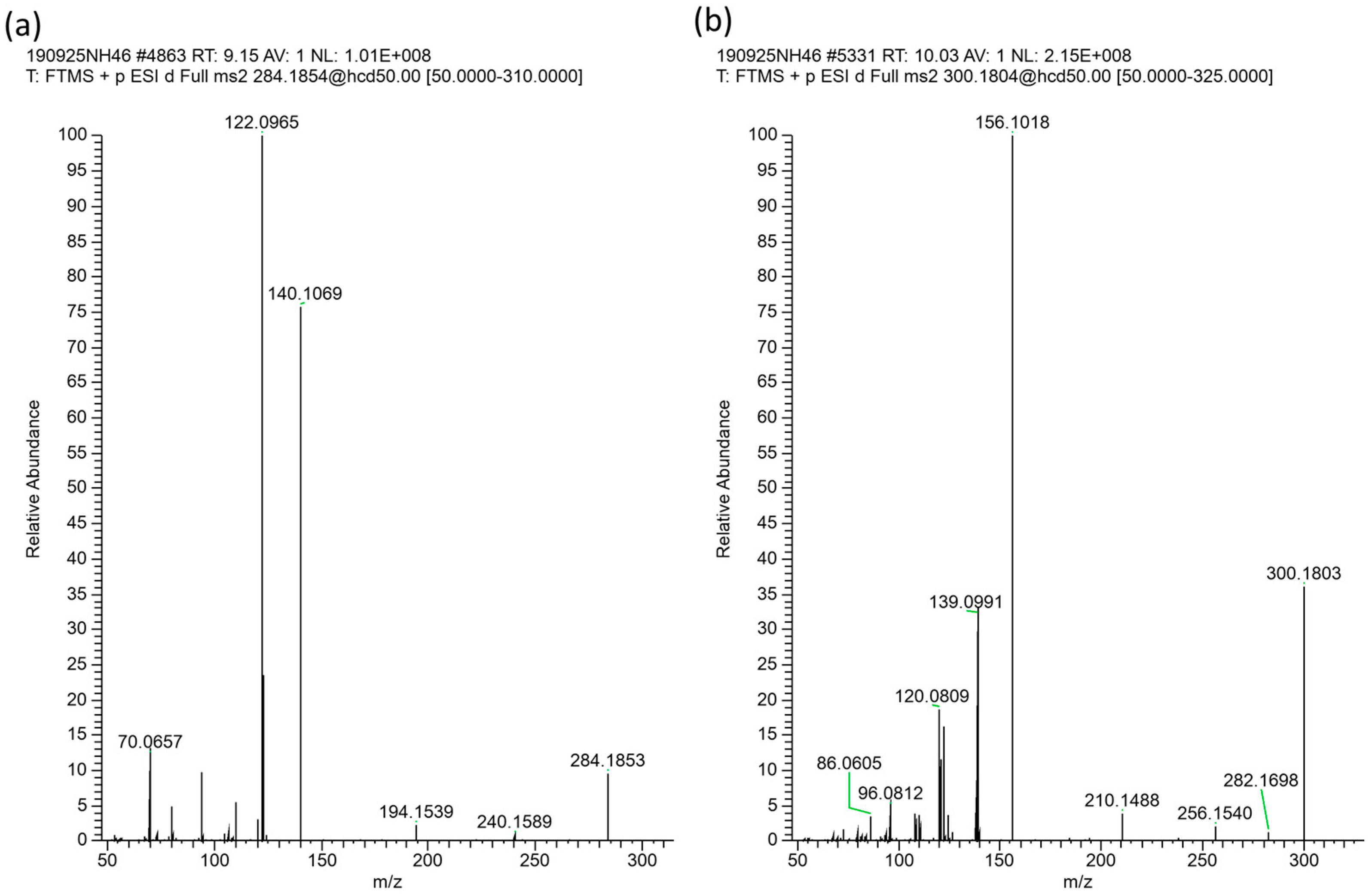
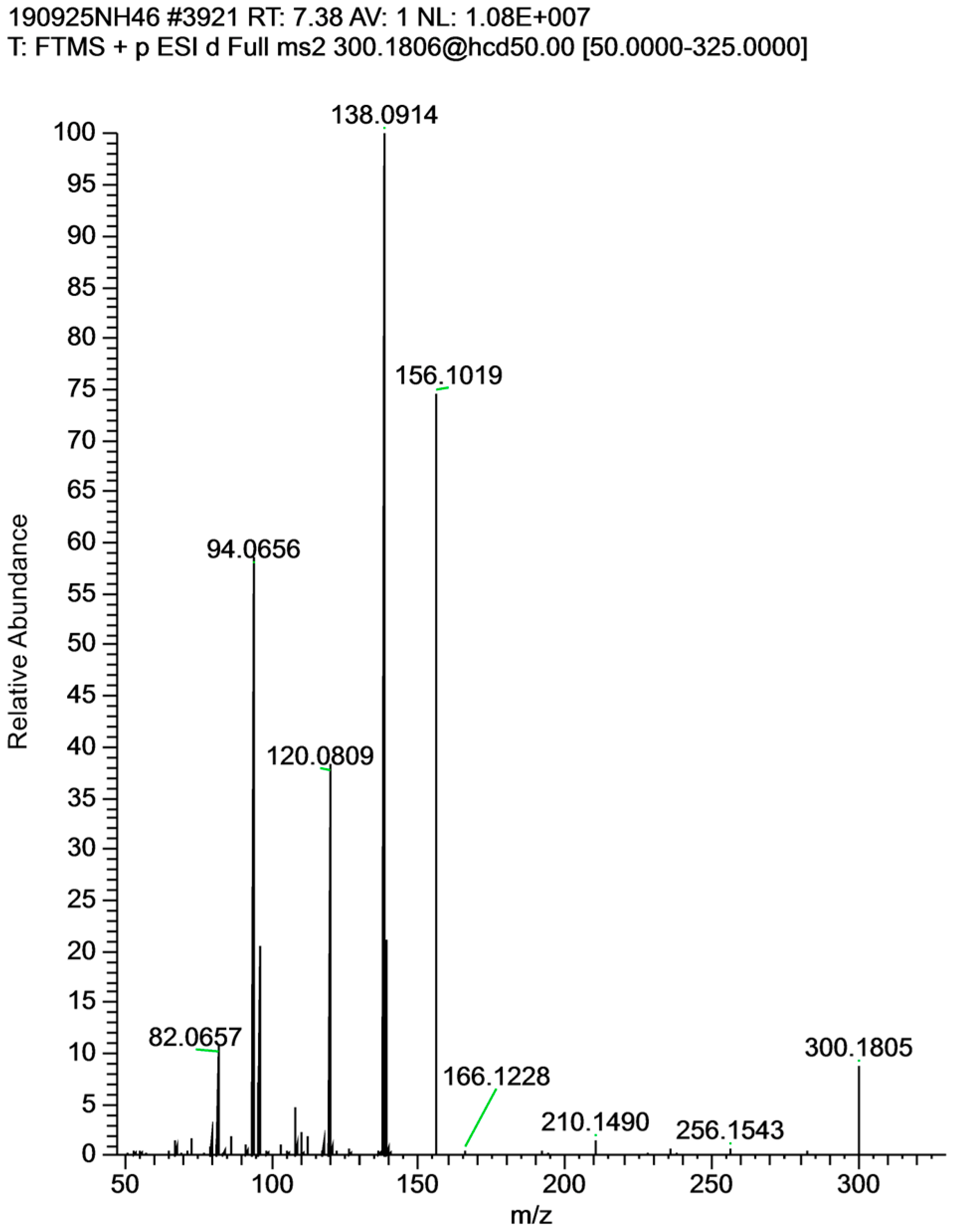

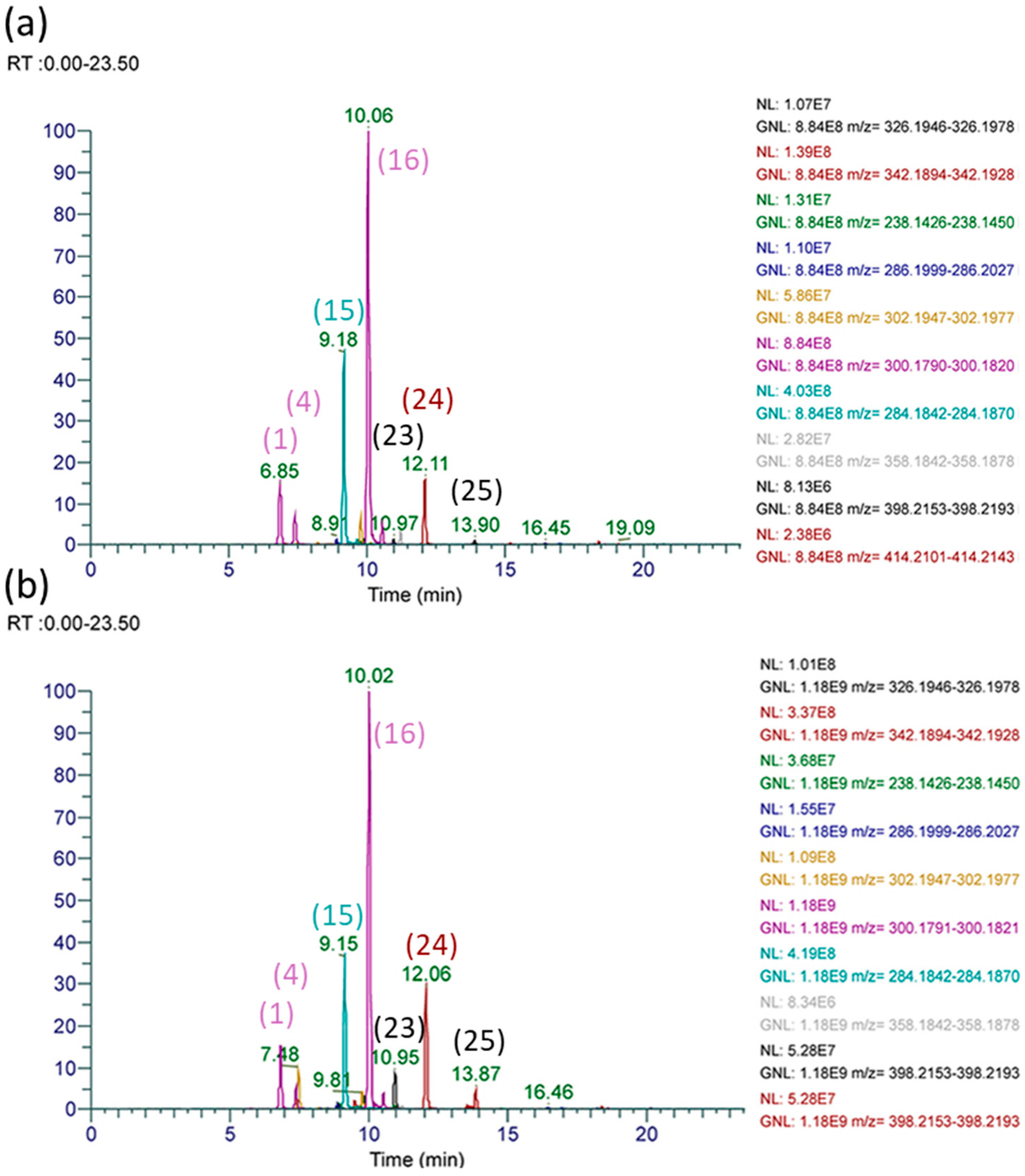
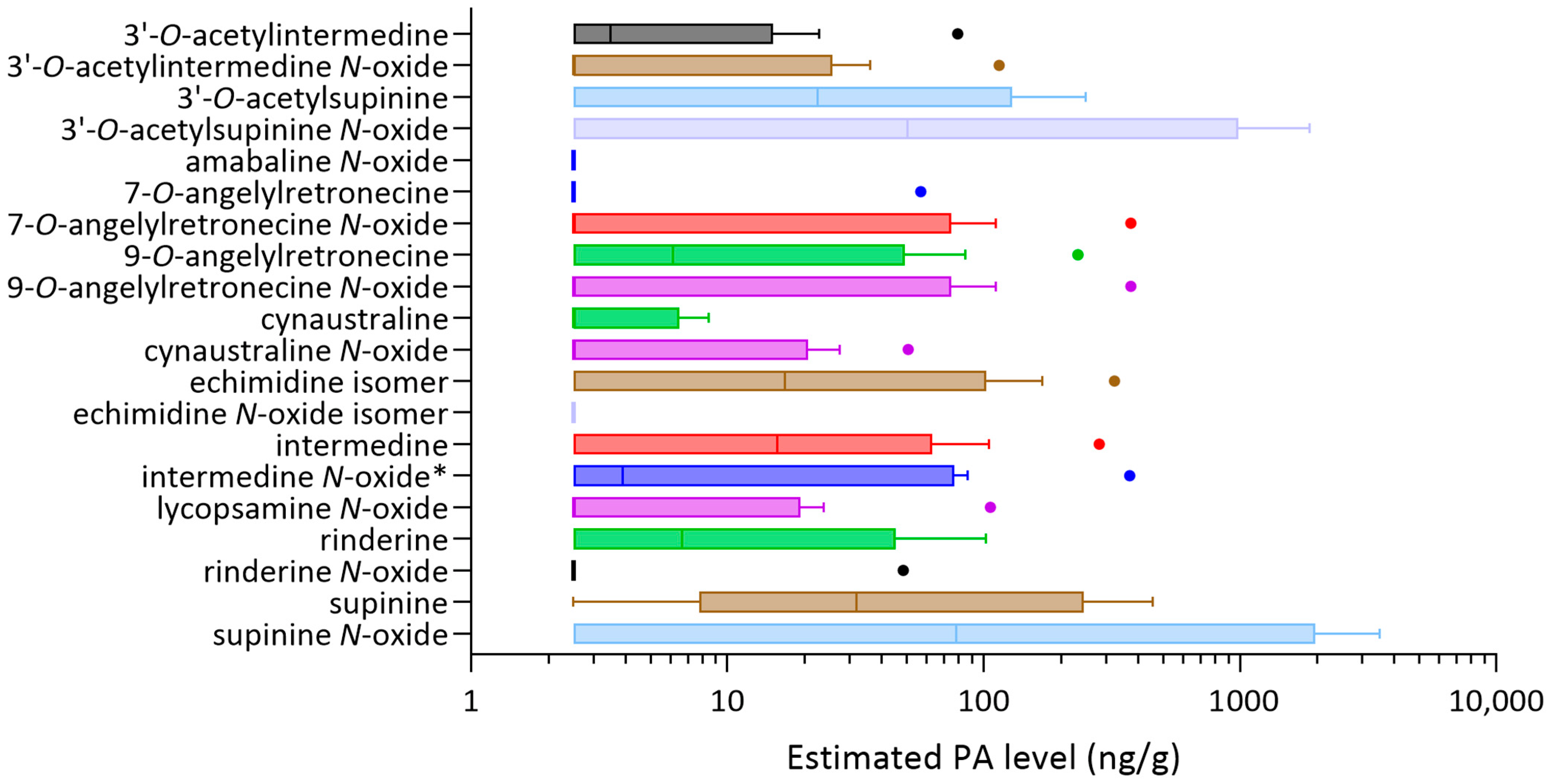
| Compound | Malaysian Stingless Bee Honeys | Australian Stingless Bee Honeys | ||||||||||
|---|---|---|---|---|---|---|---|---|---|---|---|---|
| Geniotrigona thoracica (n = 5) | Heterotrigona itama (n = 10) | Tetragonula carbonaria (n = 11) | Tetragonula hockingsi (n = 10) | |||||||||
| Mean (ng/g) | SD (ng/g) | Range (ng/g) | Mean (ng/g) | SD (ng/g) | Range (ng/g) | Mean (ng/g) | SD (ng/g) | Range (ng/g) | Mean (ng/g) | SD (ng/g) | Range (ng/g) | |
| indicine | 2.4 | 0.6 | <LOR—2.8 | 6.4 | 11.8 | <LOR—42.1 | 1.4 | 1.2 | <LOR—3.2 | <LOR | ||
| indicine N-oxide/ intermedine N-oxide a | <LOR | 62 | 110 | <LOR—391 | <LOR | 1.1 | <LOR | |||||
| intermedine | 1.9–3.8 | 52 | 85 | <LOR—297 | <LOR | 1.0 | <LOR | |||||
| jacobine | <LOR | <LOR | <LOR | 1.0 | <LOR—0.9 | <LOR | ||||||
| lycopsamine | <LOR | <LOR—2.2 | 23 | 34 | <LOR—105 | 14 | 24 | <LOR—85 | <LOR | |||
| lycopsamine N-oxide | <LOR | <LOR—2.2 | 18 | 31 | <LOR—111 | <LOR | <LOR—2.7 | <LOR | ||||
| Alkaloid | Typical RT (min) | Molecular Ion Formula | Calculated [M + H]+ | Observed [M + H]+ and Product Ions m/z (rel. abundance) |
|---|---|---|---|---|
| intermedine (1) | 6.7 | [C15H25NO5 + H]+ | 300.1806 | 300.1808 (5), 156.1021 (51), 139.0993 (11), 138.0915 (30), 120.0811 (18), 96.0813 (4), 95.0735 (4), 94.0656 (100), 82.0658 (5). |
| rinderine (4) | 7.2 | [C15H25NO5 + H]+ | 300.1806 | 300.1808 (5), 156.1021 (59), 139.0993 (16), 138.0915 (100), 120.0811 (27), 108.0812 (5), 96.0813 (20), 95.0735 (6), 94.0657 (21), 82.0658 (10) |
| rinderine N-oxide (9) | 8.4 | [C15H25NO6 + H]+ | 316.1755 | 316.1758 (30), 272.1495 (2), 226.1440 (3), 172.0970 (100), 155.0943 (18), 138.0916 (21), 136.0760 (7), 112.0761 (4), 111.0683 (10), 94.0657 (9), 93.0579 (7) |
| intermedine N-oxide (6) | 8.7 | [C15H25NO6 + H]+ | 316.1755 | 316.1758 (35), 272.1495 (2), 226.1439 (4), 172.0970 (100), 155.0943 (17), 138.0916 (55), 136.0760 (15), 111.0683 (12), 94.0657 (19), 93.0579 (14) |
| Alkaloid | Typical RT (min) | Molecular Ion Formula | Calculated [M + H]+ | Observed [M + H]+ and Product Ions m/z (rel. abundance) |
|---|---|---|---|---|
| intermedine (1) | 6.9 | [C15H25NO5 + H]+ | 300.1806 | 300.1803 (5), 156.1019 (50), 138.0913 (31), 120.0809 (19), 95.0733 (4), 94.0655 (100) |
| rinderine (4) | 7.4 | [C15H25NO5 + H]+ | 300.1806 | 300.1805 (9), 156.1019 (77), 139.0992 (20), 138.0914 (100), 120.0809 (37), 96.0812 (19), 94.0656 (58) |
| rinderine N-oxide (9) | 8.54 | [C15H25NO6 + H]+ | 316.1755 | 316.1755 (29), 272.1488 (2), 226.1434 (3), 172.0966 (100), 155.0939 (19), 138.0912 (21), 136.0756 (7), 112.0758 (4), 111.0602 (2), 94.0655 (9), 93.0577 (7) |
| cynaustraline isomer 2 | 8.6 | [C15H27NO4 + H]+ | 286.2013 | 286.2012 (28), 142.1227 (100), 125.1201 (8), 124.1124 (8) |
| intermedine N-oxide (6) | 8.84 | [C15H25NO6 + H]+ | 316.1755 | 316.1751 (34), 272.1487 (2), 226.1434 (4), 172.0967 (100), 155.0939 (17), 138.0913 (54), 136.0757 (15), 112.0759 (5), 111.0681 (11), 94.0655 (20), 93.0577 (14) |
| cynaustraline isomer | 8.9 | [C15H27NO4 + H]+ | 286.2013 | 286.2012 (34), 142.1227 (100), 124.1123 (62), 96.0812 (4) |
| 7-O-angelylretronecine (minor) | 8.94 | [C13H19NO3 + H]+ | 238.1438 | 238.1442 (20), 138.0916 (35), 120.0810 (100), 108.0812 (58), 94.0656 (40), 83.0498 (26), 80.0500 (18). |
| further lycospamine N-oxide isomer | 9.12 | [C15H25NO6 + H]+ | 316.1755 | 316.1754 (42), 272.1494 (2), 226.1437 (4), 172.0968 (100), 155.0940 (23), 138.0914 (19), 136.0758 (24), 112.0760 (3), 111.0681 (6), 94.0656 (3), 93.0578 (6) |
| supinine (15) | 9.2 | [C15H25NO4 + H]+ | 284.1856 | 284.1853 (9), 140.1069 (73), 123.1043 (22), 122.0965 (100), 110.0966 (5), 94.0655 (9). |
| lycopsamine N-oxide | 9.35 | [C15H25NO6 + H]+ | 316.1755 | 316.1751 (41), 272.1491 (2), 226.1435 (3), 172.0966 (100), 155.0939 (17), 138.0913 (63), 136.0757 (17), 112.0758 (6), 111.0680 (11), 94.0655 (21), 93.0577 (16) |
| 3′-O-acetylintermedine | 9.5 | [C17H27NO5 + H]+ | 342.1911 | 282.1690 (3), 156.1020 (24), 138.0910 (61), 120.0810 (36), 94.0656 (100), |
| 9-O-angelylretronecine | 9.8 | [C13H19NO3 + H]+ | 238.1438 | 238.1439 (2), 138.0914 (11), 120.0810 (16), 96.0812 (5), 94.0656 (100), 83.0497 (5) |
| cynaustraline N-oxide isomer | 9.8 | [C15H27NO5 + H]+ | 302.1962 | 302.1961 (10), 158.1175 (100), 141.1148 (6), 140.1070 (3), 124.1122 (9) |
| supinine N-oxide (16) | 10.1 | [C15H25NO5 + H]+ | 300.1806 | 300.1084 (38), 156.1019 (100), 139.0992 (30), 138.0913 (6) 122.0965 (16), 121.0887 (10), 120.0809 (18), 108.0811 (4) 96.0812 (4) |
| amabaline N-oxide (18) | 10.6 | [C15H25NO5 + H]+ | 300.1806 | 300.1804 (42), 156.1019 (100), 139.0991 (30), 122.0965 (18), 121.0887 (11), 120.0809 (19), 108.0810 (4), 96.0811 (4) |
| 3′-O-acetylsupinine (23) | 10.9 | [C17H27NO5 + H]+ | 326.1962 | 326.1951 (1), 266.1749 (8), 140.1069 (31), 123.1043 (15), 122.0965 (100), 120.0809 (4), 110.0967 (3), 94.0655 (12), |
| 3′-O-acetylintermedine N-oxide | 11.2 | [C17H27NO7 + H]+ | 358.186 | 358.1859 (16), 316.1754 (4), 298.1648 (38), 172.0968 (100), 155.0940 (21), 138.0914 (71), 136.0758 (25), 111.0681 (18), 94.0656 (34), 93.0577 (21). |
| 7-O-angelylretronecine N-oxide (minor) | 11.2 | [C13H19NO4 + H]+ | 254.1387 | 254.1386 (13), 172.0968 (19), 137.0836 (33), 136.0758 (16), 111.0682 (84), 106.0655 (100), 94.0656 (19), 83.0497 (23), 80 (28) |
| 9-O-angelylretronecine N-oxide | 11.9 | [C13H19NO4 + H]+ | 254.1387 | 254.1385 (77), 193.1908 (11), 154.0862 (84), 138.0913 (90), 137.0835 (37), 136.0757 (98), 126.0914(92), 108.0810 (24), 94.0655 (47), 93.0577 (100), 83.0497 (65) |
| 3′-O-acetylsupinine N-oxide (24) | 12.1 | [C17H27NO5 + H]+ | 342.1911 | 342.1908 (12), 300.1803 (3), 282.1697 (33), 156.1018 (100), 139.0991 (36), 122.0965 (28), 121.0887 (12), 120.0809 (30), 108.0810 (6), 96.0812 (7) |
| echimidine isomer (25) | 13.8 | [C20H31NO7 + H]+ | 398.2173 | 398.2173 (0), 138.0914 (6), 120.0810 (100), 108.0812 (2), 94.0656 (3), 93.0704 (3), 83.0496 (2), 55.0549 (1) |
| echimidine N-oxide isomer | 15.2 | [C20H31NO8 + H]+ | 414.2122 | 414.2122 (0), 396.2033 (8), 352.1734 (7), 254.1385 (71), 138.0914 (93), 137.08036 (100), 136.0757 (63), 120.0809 (72), 119.0732 (84), 111.0680 (31), 106.0655 (33), 94.0656 (86), 93.0577 (45), 83.0497 (20), 55.0550 (26) |
| Compound | Formula (M) | Typical RT (min) | Precursor Ion (MH+) m/z | Product Ions (m/z) | ||||
|---|---|---|---|---|---|---|---|---|
| 3′-O-acetylintermedine | C17H27NO6 | 9.5 | 342.1911 | 282.1705 | 156.1019 | 138.0913 | 120.0808 | 94.0651 |
| 3′-O-acetylintermedine N-oxide | C17H27NO7 | 11.2 | 358.1860 | 298.1649 | 172.0964 | 155.0941 | 138.0915 | 111.0682 |
| 3′-O-acetylsupinine | C17H27NO5 | 10.9 | 326.1962 | 266.1756 | 140.1075 | 122.0970 | 94.0656 | |
| 3′-O-acetylsupinine N-oxide | C17H27NO6 | 12.1 | 342.1911 | 282.1705 | 156.1025 | 139.0907 | 120.0810 | |
| amabaline N-oxide | C15H25NO5 | 10.6 | 300.1805 | 156.1025 | 139.0991 | 122.0965 | 120.0810 | |
| 7-O-angelylretronecine | C13H19NO3 | 8.9 | 238.1438 | 138.0914 | 120.0810 | 108.0813 | 94.0653 | |
| 7-O-angelylretronecine N-oxide | C13H19NO4 | 11.2 | 254.1387 | 172.0968 | 137.0833 | 106.0655 | 94.0653 | |
| 9-O-angelylretronecine | C13H19NO3 | 9.8 | 238.1438 | 138.0914 | 120.0810 | 94.0653 | ||
| 9-O-angelylretronecine N-oxide | C13H19NO3 | 11.9 | 254.1387 | 154.0862 | 138.0913 | 136.0757 | 93.0577 | |
| cynaustraline isomer | C15H27NO4 | 8.9 | 286.2013 | 142.1226 | 124.1121 | |||
| cynaustraline N-oxide isomer | C15H27NO5 | 9.8 | 302.1962 | 158.1176 | 140.1070 | 124.1124 | ||
| echimidine isomer | C20H31NO7 | 13.8 | 398.2173 | 138.0914 | 120.0809 | 83.0497 | 55.0550 | |
| echimidine N-oxide isomer | C20H31NO8 | 15.2 | 414.2122 | 254.1139 | 138.0914 | 137.0804 | ||
| rinderine | C15H25NO5 | 6.80 | 300.1806 | 156.1017 | 138.0914 | 120.0808 | 94.0655 | |
| rinderine N-oxide | C15H25NO6 | 8.54 | 316.1755 | 172.0964 | 155.0937 | 138.0911 | 136.0755 | 94.0654 |
| supinine | C15H25NO4 | 9.2 | 284.1856 | 140.1075 | 122.0970 | |||
| supinine N-oxide | C15H25NO5 | 10.1 | 300.1806 | 156.1025 | 138.0919 | |||
| SBH Code | Species | Country | Region | LOR for Each PA Standard (ng/g) |
|---|---|---|---|---|
| GT-1 | Geniotrigona thoracica | Malaysia | Selangor | 5 |
| GT-2 | Selangor | 5 | ||
| GT-3 | Selangor | 5 | ||
| GT-4 | Selangor | 5 | ||
| GT-5 | Selangor | 0.75 | ||
| HI-1 | Heterotrigona itama | Malaysia | Sarawak | 5 |
| HI-2 | Selangor | 5 | ||
| HI-3 | Selangor | 5 | ||
| HI-4 | Selangor | 5 | ||
| HI-5 | Johor | 5 | ||
| HI-6 | Selangor | 5 | ||
| HI-7 | Selangor | 5 | ||
| HI-8 | Kedah | 5 | ||
| HI-9 | Selangor | 5 | ||
| HI-10 | Selangor | 5 | ||
| TC-1 | Tetragonula carbonaria | Australia | Brisbane | 5 |
| TC-2 | Brisbane | 0.75 | ||
| TC-3 | Brisbane | 0.75 | ||
| TC-4 | Brisbane | 0.75 | ||
| TC-5 | Brisbane | 0.75 | ||
| TC-6 | Brisbane | 5 | ||
| TC-7 | Brisbane | 5 | ||
| TC-8 | Brisbane | n/a | ||
| TC-9 | Brisbane | 0.75 | ||
| TC-10 | Brisbane | 0.75 | ||
| TC-11 | Brisbane | 0.75 | ||
| TH-1 | Tetragonula hockingsi | Australia | Bundaberg | 5 |
| TH-2 | Bundaberg | 0.75 | ||
| TH-3 | Bundaberg | 0.75 | ||
| TH-4 | Bundaberg | 0.75 | ||
| TH-5 | Brisbane | 0.75 | ||
| TH-6 | Brisbane | 0.75 | ||
| TH-7 | Brisbane | 0.75 | ||
| TH-8 | Brisbane | 5 | ||
| TH-9 | Brisbane | 0.75 | ||
| TH-10 | Brisbane | 5 |
Disclaimer/Publisher’s Note: The statements, opinions and data contained in all publications are solely those of the individual author(s) and contributor(s) and not of MDPI and/or the editor(s). MDPI and/or the editor(s) disclaim responsibility for any injury to people or property resulting from any ideas, methods, instructions or products referred to in the content. |
© 2024 by the authors. Licensee MDPI, Basel, Switzerland. This article is an open access article distributed under the terms and conditions of the Creative Commons Attribution (CC BY) license (https://creativecommons.org/licenses/by/4.0/).
Share and Cite
Hungerford, N.L.; Zawawi, N.; Zhu, T.; Carter, S.J.; Melksham, K.J.; Fletcher, M.T. Analysis of Pyrrolizidine Alkaloids in Stingless Bee Honey and Identification of a Botanical Source as Ageratum conyzoides. Toxins 2024, 16, 40. https://doi.org/10.3390/toxins16010040
Hungerford NL, Zawawi N, Zhu T, Carter SJ, Melksham KJ, Fletcher MT. Analysis of Pyrrolizidine Alkaloids in Stingless Bee Honey and Identification of a Botanical Source as Ageratum conyzoides. Toxins. 2024; 16(1):40. https://doi.org/10.3390/toxins16010040
Chicago/Turabian StyleHungerford, Natasha L., Norhasnida Zawawi, Tianqi (Evonne) Zhu, Steve J. Carter, Kevin J. Melksham, and Mary T. Fletcher. 2024. "Analysis of Pyrrolizidine Alkaloids in Stingless Bee Honey and Identification of a Botanical Source as Ageratum conyzoides" Toxins 16, no. 1: 40. https://doi.org/10.3390/toxins16010040
APA StyleHungerford, N. L., Zawawi, N., Zhu, T., Carter, S. J., Melksham, K. J., & Fletcher, M. T. (2024). Analysis of Pyrrolizidine Alkaloids in Stingless Bee Honey and Identification of a Botanical Source as Ageratum conyzoides. Toxins, 16(1), 40. https://doi.org/10.3390/toxins16010040








